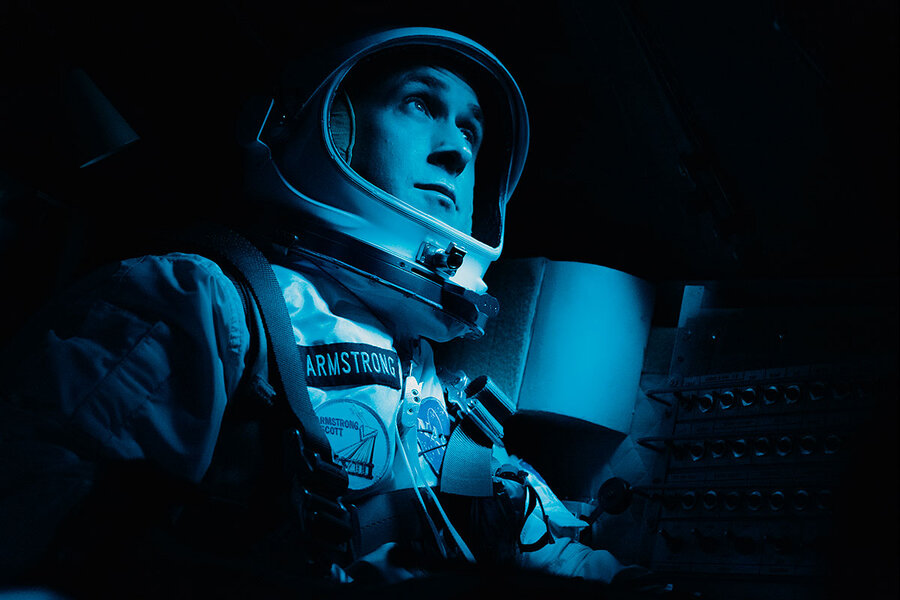Neil Armstrong gets the spotlight in the biopic ‘First Man’
Loading...
If you ever wanted to know what it feels like to be rattling around inside the cockpit of an aircraft as it bounces off the atmosphere, the opening sequence of “First Man” will more than serve its purpose. A pre-NASA Neil Armstrong, played by Ryan Gosling, is testing an X-15 aircraft, and the shake, rattle, and roll, as experienced in immersive IMAX, is overwhelming.
As long as “First Man” is airborne, it’s a marvel. I can’t recall another movie that conveyed with such punch the perils and exhilarations of spaceflight. It’s when the film is earthbound that it falls down. Damien Chazelle, working from a script by Josh Singer based on the authorized Armstrong biography by James R. Hansen, is after more than just pyrotechnics here. He wants to demythologize an American hero, which is not the same as deglorifying him. If anything, this film’s ordinary-man-in-
extraordinary-times portrait is intended to enhance Armstrong’s specialness: He was a human being who accomplished the superhuman.
The problem is, the filmmakers overcorrected. As Gosling plays him, Armstrong is not so much strong and silent as glazed-over. It is, in its way, a daring performance: Gosling doesn’t offer the slightest sentimental sop to the audience. We are free to read all kinds of emotional depths into Armstrong’s stony silences – as a clue to his character, much is made of the death of his young daughter from cancer in 1962, which he never discussed in public and hardly ever in private – but the fact remains that, as the centerpiece of a movie about grand exploits, he doesn’t fill the screen. This is an antihero hero movie. Armstrong here is not some aw-shucks Gary Cooper type of Everyman. He’s more like “Everyenigma.”
As Armstrong progresses from test pilot to the first man to set foot on the moon in the Apollo 11 mission in 1969, Armstrong’s journey seems not so much predestined as procedural. Unlike, say, Buzz Aldrin (Corey Stoll), who is portrayed in the movie as an arrogant opportunist, Armstrong shunned the spotlight before and after the moon landing, and the movie implies he would have been just as happy, or just as stoic, had he not been chosen to make history.
“First Man” was initially criticized as unpatriotic by some, including Aldrin, for not giving us a big fat close-up of the American flag being planted on the moon. Much of this criticism emanated from people who had not yet seen the movie, but when you watch the film, it makes perfect sense that Chazelle would skimp on a soaring, tub-thumping moment in favor of something more fragile and indrawn. Whatever one thinks of how Armstrong is portrayed here, in dramatic terms, his recessiveness does not lend itself to grand gestures. (His big moment on the moon is a wordless one memorializing his daughter.)
Still, it’s difficult to enter into emotional sympathy with Armstrong when, for example, he has to be scolded by his wife, Janet (forcefully played by Claire Foy in a somewhat thankless role), into having a sit-down with his two sons prior to blasting off to the moon, letting them know there’s a chance he may not come back. When he finally returns home a global hero and is quarantined and Janet sees him for the first time since touching down, the couple still seems at odds over that scolding. I guess some marital squabbles even a moonwalk can’t fix.
Chazelle, whose previous movie was “La La Land,” is not one to repeat himself, and, purely in technical terms, “First Man” is wildly ambitious. The cinematographer, Linus Sandgren, uses varying film stocks – 16 mm, 35 mm, and 70-mm IMAX – for different sections of the movie, and the results are dizzyingly effective. The score by Justin Hurwitz is complexly nuanced for such a big picture, without a trace of spooky-cheesy sci-fi sounds. It all might have come together if not for the film’s deadpan core.
One of the reasons Philip Kaufman’s “The Right Stuff” remains for me easily the best movie of its kind is that it was crammed with so much crazymaking energy and high spirits. It turned the cold-war space race into knockabout grand theater, and I think this is how many of us reacted to that patriotic pageant at the time. “First Man” pays lip service to the politics of the cold war that surrounded the moon shot, but it’s not that kind of movie, really. For all its scale and ambition, it’s essentially a small-scale character study. The character, Armstrong, is microscopic, and the backdrop is macroscopic. It’s an odd, uneasy fit. Grade: B- (Rated PG-13 for some thematic content involving peril, and brief strong language.)







